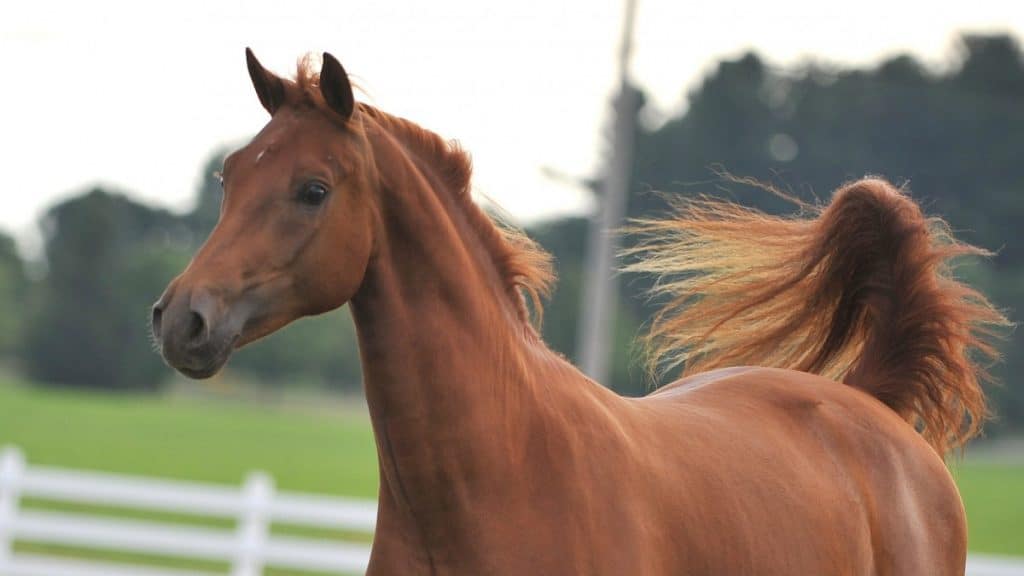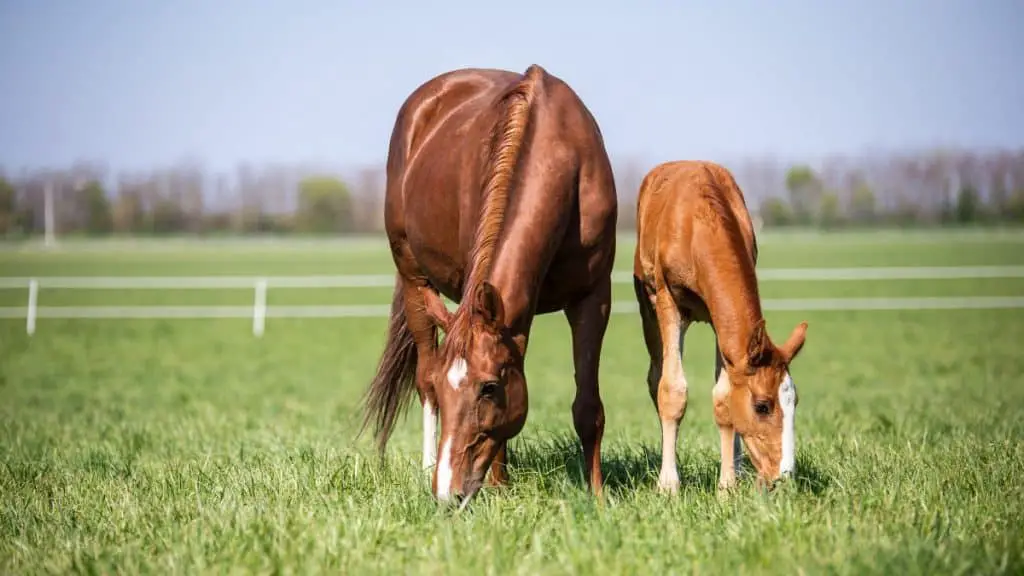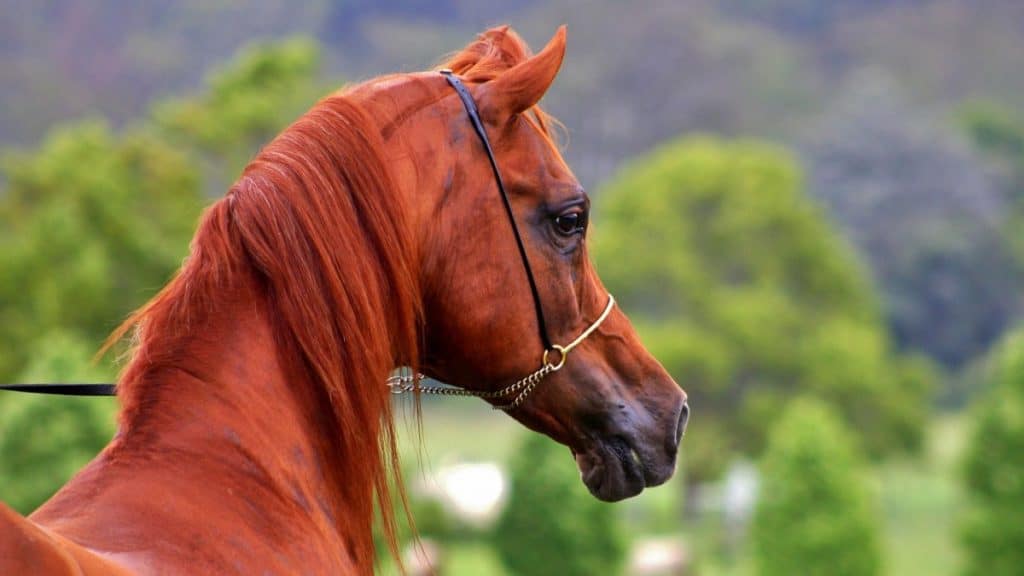Skip To Section
What Is A Chestnut Horse?
A chestnut horse has a coat of a reddish-brown color, containing no black hairs, along with a mane and tail of the same or a lighter color.
In horses, the term ‘chestnut’ refers to color and includes numerous shades of red-brown all produced by the same genotype. Chestnut is found across many horse breeds and is one of the most common coat colors.
Anyone interested in horses will probably have observed that their coats come in a wide range of colors and patterns.
Interestingly, the coat colors we observe are all variations on three main base colors, black, chestnut (red), and bay (a mixture of black and red).
Breed, physical conformation, and temperament are all of primary importance, but after considering these factors many horse breeders, riders or other enthusiasts will also have a favorite horse color.
If you particularly love chestnut horses or want to learn more about their coloring, take a look at our short guide to chestnut horses below.

What Does A Chestnut Horse Look Like?
Chestnut horses come in a range of red-brown shades across a wide spectrum from light red, through dark red, to dark brown-red.
The manes and tails of chestnut horses may be a similar color, a lighter red, or even blond. Black hair is completely absent in all chestnut horses.
It is color, and its underpinning genetic markers, which provide the defining feature of chestnut horses rather than other physical features.
Chestnut horses can be found in many different breeds of different sizes, shapes, and origins. There is no one common chestnut horse ancestor.
Some breeds are exclusively chestnut while others may feature chestnut horses amongst several other colors.
What Color Is A Chestnut Horse?
There are a variety of different shades of chestnut included within the overall color designation. In a simple ‘chestnut horse’ or ‘red horse’, the coat is a solid, coppery shade of red, with a mane and tail very close to the same color.
As coloring becomes lighter or darker, or we observe areas of white hair on the horse’s base coat color, we find that there are further distinctions within the chestnut horse color classification.
Descriptive terms may be used to distinguish differently colored chestnut horses even though the shade variations themselves are not genetically distinguishable.
For example:
- Sorrel. Sorrel can be used to describe red horses with manes and tails the same shade or lighter than their body. In some places, it can also be used interchangeably with chestnut as colloquial terms for copper-red horses.
- Liver chestnut. This is another descriptive term for a very dark-reddish brown, also known as ‘dark chestnut’. The darkest chestnut horses may be almost indistinguishable from true black coloring without DNA testing.
- Flaxen chestnut or blond chestnut. These are descriptive terms for manes and/or tails significantly lighter than the horse’s coat.
White markings can be found in all colors of a horse but chestnut horses normally have more of these distinguishing features than bay or black-colored horses.
Examples of horse breeds with a chestnut base and white markings include the Icelandic, Appaloosa, and American Paint Horse.
Horses may also grow white hairs due to the ‘pangaré’ or ‘mealy’ genetic modifier. Pangaré lightens the coat of chestnut and bay horses at soft spots including the muzzle, belly, inner legs, and around the eyes.
Chestnut Horse Breeds
There is no single chestnut breed. Rather, chestnut coloring and its associated genotype are found across many different horse breeds, each of which has its own distinct set of genetic and physical characteristics.
Horse breed associations monitor and maintain genetic and physical criteria for belonging to a breed. They hold breed registries for horses who meet certain qualifications in terms of pedigree and other characteristics, which might include color.
Some horse breed associations might require chestnut coloring for registration, but chestnut coloring alone would not guarantee acceptance to the breed register.
In contrast to the pedigree-based registers, color breed registries are based primarily on a horse’s coat color, regardless of breed or type. Some color breed registries may be limited to horses who also meet certain pedigree criteria. Others might be open to animals based entirely on color, without reference to parentage.
A chestnut horse could potentially be double registered, once for its pedigree on a breed register, and on account of coloring on a color breed register.
Amongst the most famous horse breeds associated with chestnut coloring are the sturdy Suffolk Punch and Belgian Draft. Chestnut coloring is also common or possible in many others, including the American Quarter Horse.
Let’s take a brief look at some of the main horse breeds featuring chestnut horses…
1. American Quarter Horse
The most popular horse breed in the USA, the most common color of the American Quarter Horse is sorrel, which part of the chestnut spectrum in the majority of breed registries.
2. Belgian Draft
One of the biggest horse breeds in the world, the Belgian Draft horse is traditionally chestnut in coloring.
3. Budyonny
An intelligent and adaptable Russian breed dating from the first half of the twentieth century, Budyonny horses are usually chestnut.
4. Frederiksborg
The Danish Frederiksborg horse is the oldest pedigree horse breed in the world, originally bred for the service of the Danish monarchy. Frederiksborg horses are always chestnut.
5. Gidran

An Anglo-Arabian breed originating in 19th century Hungary, the Gidran is primarily chestnut in color.
6. Lithuanian Draft
A large, tough horse breed which was developed in the early 20th century, the Lithuanian Draft horse’s traditional colors are chestnut or bay.
7. Mangalarga Pulista
Very similar to the Mangalarga Marchador breed from which they were developed in Brazil, the Mangalarga Pulista’s traditional colors are chestnut or grey.
8. Pleven
Originally a half-breed which crossed Arabian and Anglo-Arabian stock with local Bulgarian horses, Plevens were established as a breed in 1951. Their traditional color is chestnut.
9. Russian Heavy Draft
This sturdy but not overly large breed was introduced in 1900 at the Paris Exhibition. The Russian Heavy Draft horse’s traditional colors are chestnut or bay.
10. Suffolk Punch
One of the oldest draft horse breeds in Great Britain, dating back to the 16th century, the Suffolk Punch is always chestnut-colored and comes in seven recognized shades.
11. Tolfetano
A hardy Italian horse from the mountainous Tolfa area, the Tolfetano was recognized as a breed in 1992. Its traditional colors are chestnut and bay.
12. Tori
Developed in Estonia in the early 20th century, the Tori horse breed’s traditional colors are chestnut or bay.
13. Yonaguni

A very rare breed of pony which comes from the southwestern islands of Japan, the Yonaguni’s traditional colors are chestnut or bay.
How Do You Get One?
In contrast to black and grey horses whose coloring may have developed through natural selection to better fit them for certain environments, chestnut coloring has often been created directly by humans through selective horse breeding.
The color of an animal’s coat and other hair comes from the pigment melanin. In horses, there are two forms of this pigment, eumelanin (black) and phaeomelanin (red-brown). Every horse coat color results from the presence, absence, or combination of these two pigments, along with various genetic modifiers. Additional gene influences on the base colors can create a huge range of possible coat colors.
Whether a horse will have a chestnut, black or bay base coat color is determined by its inherited versions of the extension gene, or ‘red factor’, also known as the melanocortin 1 receptor (MC1R) gene. The dominant allele of the red factor is designated ‘E’ and the recessive allele is designated ‘e’. One version will be inherited from each parent.
Chestnut horses must possess two copies of the recessive e/e allele. If a horse has at least one copy of the dominant allele (E/E or E/e) it will produce black pigment in its coat and will not be a chestnut horse. It if is homozygous for this gene (E/E) it will not be able to produce chestnut offspring.
Chestnut coloring can be true-breeding, where as long as they carry no recessive modifiers, two chestnut horse parents will always produce chestnut foals. The results can be seen in breeds such as the Suffolk Punch and Haflinger, which are exclusively chestnut.
At the same time, two non-chestnut horses can also produce a chestnut foal if each parent horse carries the recessive chestnut gene (i.e. E/e + E/e) and both recessive forms are passed on. Again we can see real-life illustrations in certain breeds (e.g. Friesian horse, Ariegeois pony) where black coat color has been selected by breeders for many years but chestnut foals are still occasionally born.
Where Can I Get A Chestnut Breed?
As with any other color of horse, chestnut horses can be bought from private sellers, breeders or dealers, or from riding schools or other equine businesses. You may also be able to buy horses at horse shows or at auction.
Dedicated horse websites, magazine publications, and breed association literature may all carry horse sale adverts or links to sellers.
Make sure you are well informed about breeds and general horse upkeep and welfare before buying a horse. Investigate individual horses on sale thoroughly before purchase to ensure they fit your needs.
How Much Do They Cost?

The cost of buying a horse varies considerably according to breed, pedigree, age, size, and training. Horse color, including chestnut, will often be a matter of owner preference rather than a major driver of price, although certain colors may be more or less desirable within specific breeds.
Thoroughbred racing horses of all colors, and top specimens from other breeds, can sell for tens of millions of US dollars. Healthy horses from many breeds with good pedigrees can sell for tens or hundreds of thousands of US dollars.
In the UK, the price of horses for sale in a typical online marketplace can vary from as little as £500 up to well over £40,000.
The price of a chestnut horse should fall roughly within these indicative prices for all horses.
Final Words…
Chestnut horses are a color classification and genotype rather than one particular breed and you will find chestnut horses across many breeds all over the world.
If you are buying a horse, make sure you consider breed, physical form, and temperament first, before focusing on color. This will help you identify the perfect chestnut horse for your needs.
You can learn even more about horses and horse coat colors on the Amazing Horse Facts website.
References
- https://vgl.ucdavis.edu/test/red-factor-horse
- https://horseracingsense.com/chestnut-sorrel-horses-color/
- https://animal-world.com/horses/information/horse-colors.php
- http://www.theequinest.com/colors/base/chestnut/
Related Posts
- What is a chestnut horse and what do they look like?
- What is a dapple gray horse?
- What is a grulla horse and what do they look like?
- What is a palomino horse?
- What is a piebald horse?
- What is a pinto horse?
- What is a smoky black horse and what do they look like?
- What is a sorrel horse and what do they look like?
